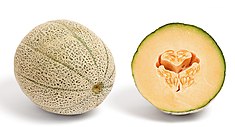Cantaloupe
Variety of melon From Wikipedia, the free encyclopedia
Variety of melon From Wikipedia, the free encyclopedia
The cantaloupe (/ˈkæntəloʊp/ KAN-tə-lohp) is a type of true melon (Cucumis melo) with sweet, aromatic, and usually orange flesh. Originally, cantaloupe refers to the true cantaloupe or European cantaloupe with non- to slightly netted and often ribbed rind. Today, it also refers to the muskmelon with strongly netted rind,[1] which is called cantaloupe in North America (hence the name American cantaloupe), rockmelon in Australia and New Zealand, and spanspek in Southern Africa. Cantaloupes range in mass from 0.5 to 5 kilograms (1 to 11 lb).
| Cantaloupe | |
|---|---|
 European cantaloupe (true cantaloupe) | |
| Genus | Cucumis |
| Species | C. melo |
| Subspecies | C. melo subsp. melo |
| Cultivar group | Cantalupensis Group (incorporating Reticulatus Group[1]) |

 American Eastern cantaloupe and its cross-section | |||||||||||||||||||||||||||||||||||||||||||||||
| Nutritional value per 100 g (3.5 oz) | |||||||||||||||||||||||||||||||||||||||||||||||
|---|---|---|---|---|---|---|---|---|---|---|---|---|---|---|---|---|---|---|---|---|---|---|---|---|---|---|---|---|---|---|---|---|---|---|---|---|---|---|---|---|---|---|---|---|---|---|---|
| Energy | 141 kJ (34 kcal) | ||||||||||||||||||||||||||||||||||||||||||||||
8.16 g | |||||||||||||||||||||||||||||||||||||||||||||||
| Sugars | 7.86 g | ||||||||||||||||||||||||||||||||||||||||||||||
| Dietary fiber | 0.9 g | ||||||||||||||||||||||||||||||||||||||||||||||
0.18 g | |||||||||||||||||||||||||||||||||||||||||||||||
0.82 g | |||||||||||||||||||||||||||||||||||||||||||||||
| |||||||||||||||||||||||||||||||||||||||||||||||
| Other constituents | Quantity | ||||||||||||||||||||||||||||||||||||||||||||||
| Water | 90.2 g | ||||||||||||||||||||||||||||||||||||||||||||||
| †Percentages estimated using US recommendations for adults,[2] except for potassium, which is estimated based on expert recommendation from the National Academies.[3] | |||||||||||||||||||||||||||||||||||||||||||||||
The name cantaloupe was derived in the 18th century via French cantaloup from The Cantus Region of Italian Cantalupo, which was formerly a papal county seat near Rome, after the fruit was introduced there from Armenia.[4] It was first mentioned in English literature in 1739.[5] The cantaloupe most likely originated in a region from South Asia to Africa.[5] It was later introduced to Europe, and around 1890, became a commercial crop in the United States.[5]
Melon derived from use in Old French as meloun during the 13th century, and from Medieval Latin melonem, a kind of pumpkin.[6] It was among the first plants to be domesticated and cultivated.[6]
The South African English name spanspek dates back at least as far as 18th-century Dutch Suriname: J. van Donselaar wrote in 1770, "Spaansch-spek is the name for the form that grows in Suriname which, because of its thick skin and little flesh, is less consumed."[7] A common etymology involves the Spanish-born Juana María de los Dolores de León Smith, who ate canteloupe for breakfast while her husband and 19th-century governor of Cape Colony, Sir Harry Smith, ate bacon and eggs; the fruit was termed Spanish bacon (Afrikaans Spaanse spek) by locals as a result.[8][9] However, the term had been in use long before that point.
The true or European cantaloupe (Cantalupensis Group sensu stricto), which has non- to slightly netted rind and orange flesh, includes the following types:[1]
The Israeli cantaloupe (Sub-group Ha'Ogen) is similar to the European one, but it has green flesh.[1]
The muskmelon or American cantaloupe (formerly Reticulatus Group but now merged into Cantalupensis Group), which has strongly netted rind and orange flesh, includes the following types:[1]
A melon with netted rind is not necessarily a cantaloupe. Many varieties of Chandalak Group and Ameri Group also have netted rind.[1]
The Japanese muskmelon (Sub-group Earl's) resembles the American cantaloupe in netted rind, but differs in green flesh and non-dehiscent peduncles (which means the melon does not detach from the stalk when it is ripe). Therefore, some horticulturists classify the Japanese muskmelon under Inodorus Group instead of Cantalupensis or Reticulatus Group.[1]
In 2016, global production of melons, including cantaloupes, totaled 31.2 million tons, with China accounting for 51% of the world total (15.9 million tons).[10] Other significant countries growing cantaloupe were Turkey, Iran, Egypt, and India producing 1 to 1.9 million tons, respectively.[10]
California grows 75% of the cantaloupes in the US.[11]
Cantaloupe is normally eaten as a fresh fruit, as a salad, or as a dessert with ice cream or custard. Melon pieces wrapped in prosciutto are a familiar antipasto. The seeds are edible and may be dried for use as a snack.
Because the surface of a cantaloupe can contain harmful bacteria—in particular, Salmonella[12]—it is recommended that a melon be washed and scrubbed thoroughly before cutting and consumption to prevent risk of Salmonella or other bacterial pathogens.[13]
A moldy cantaloupe in a Peoria, Illinois, market in 1943 was found to contain the highest yielding strain of mold for penicillin production, after a worldwide search.[14][15]
Raw cantaloupe is 90% water, 8% carbohydrates, 0.8% protein and 0.2% fat (table). In a reference amount of 100 grams (3.5 oz), raw cantaloupe supplies 140 kJ (34 kcal) of food energy, and is a rich source (20% or more of the Daily Value, DV) of vitamin A (29% DV) and a moderate source of vitamin C (13% DV). Other micronutrients are in negligible amounts (less than 10% DV) (table).
Seamless Wikipedia browsing. On steroids.
Every time you click a link to Wikipedia, Wiktionary or Wikiquote in your browser's search results, it will show the modern Wikiwand interface.
Wikiwand extension is a five stars, simple, with minimum permission required to keep your browsing private, safe and transparent.